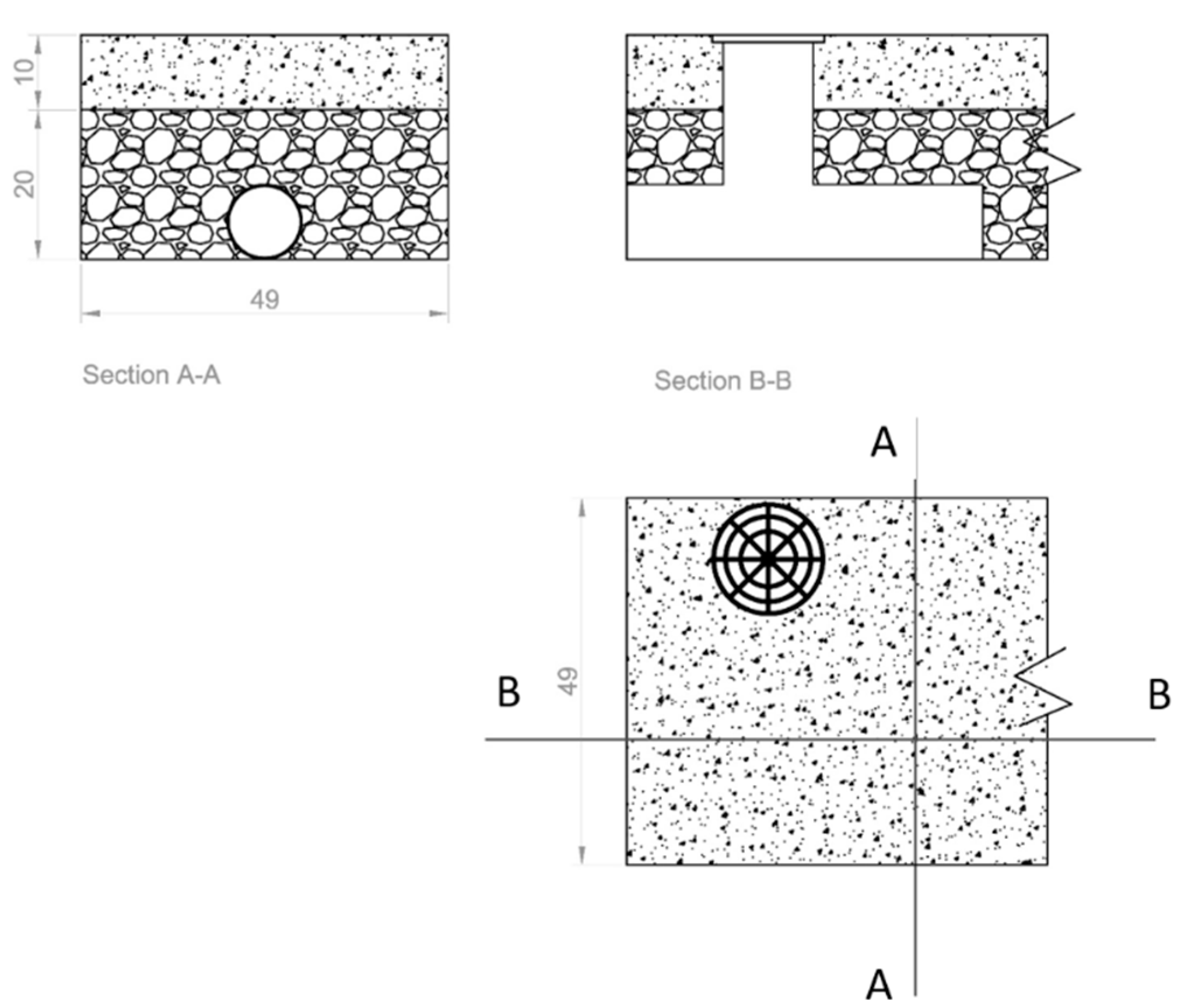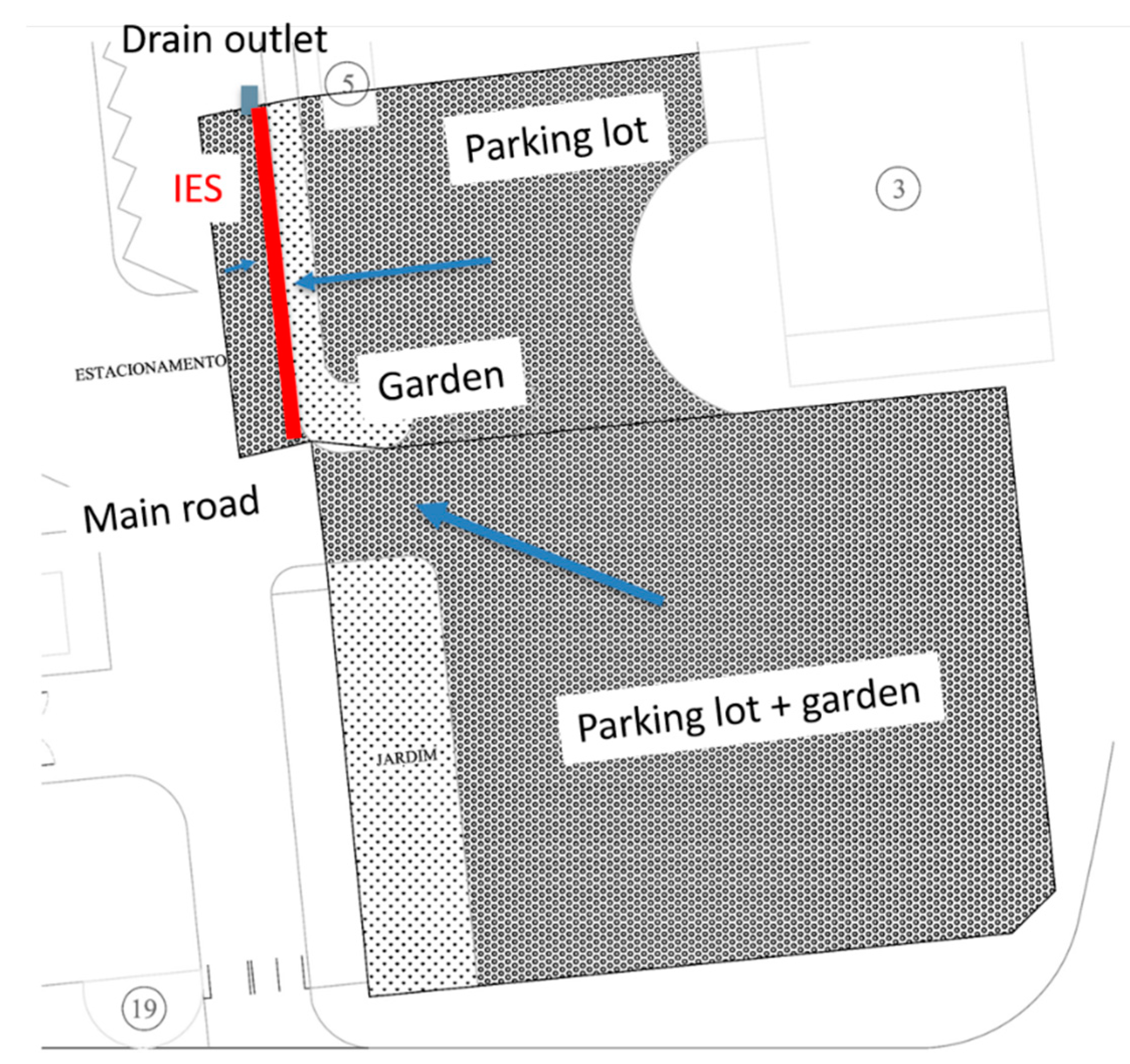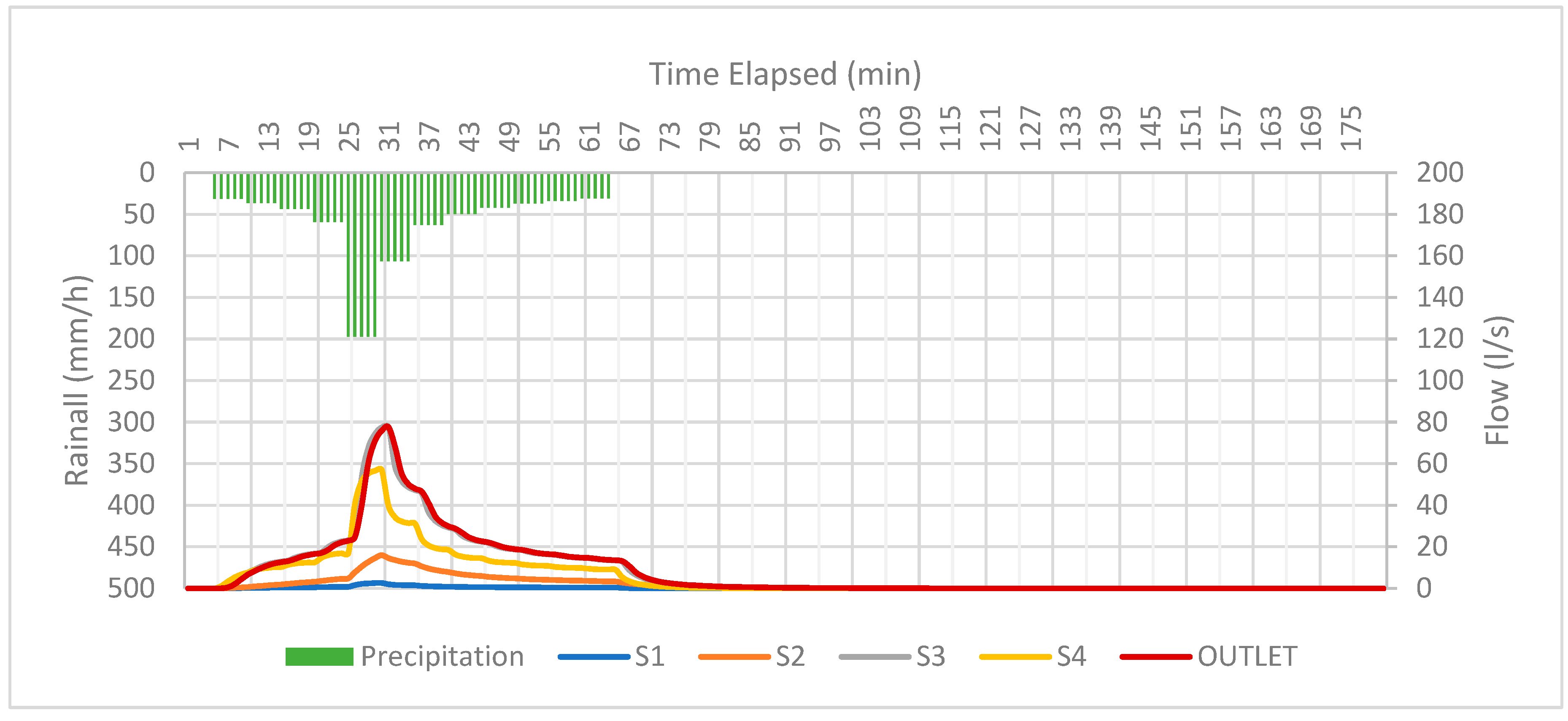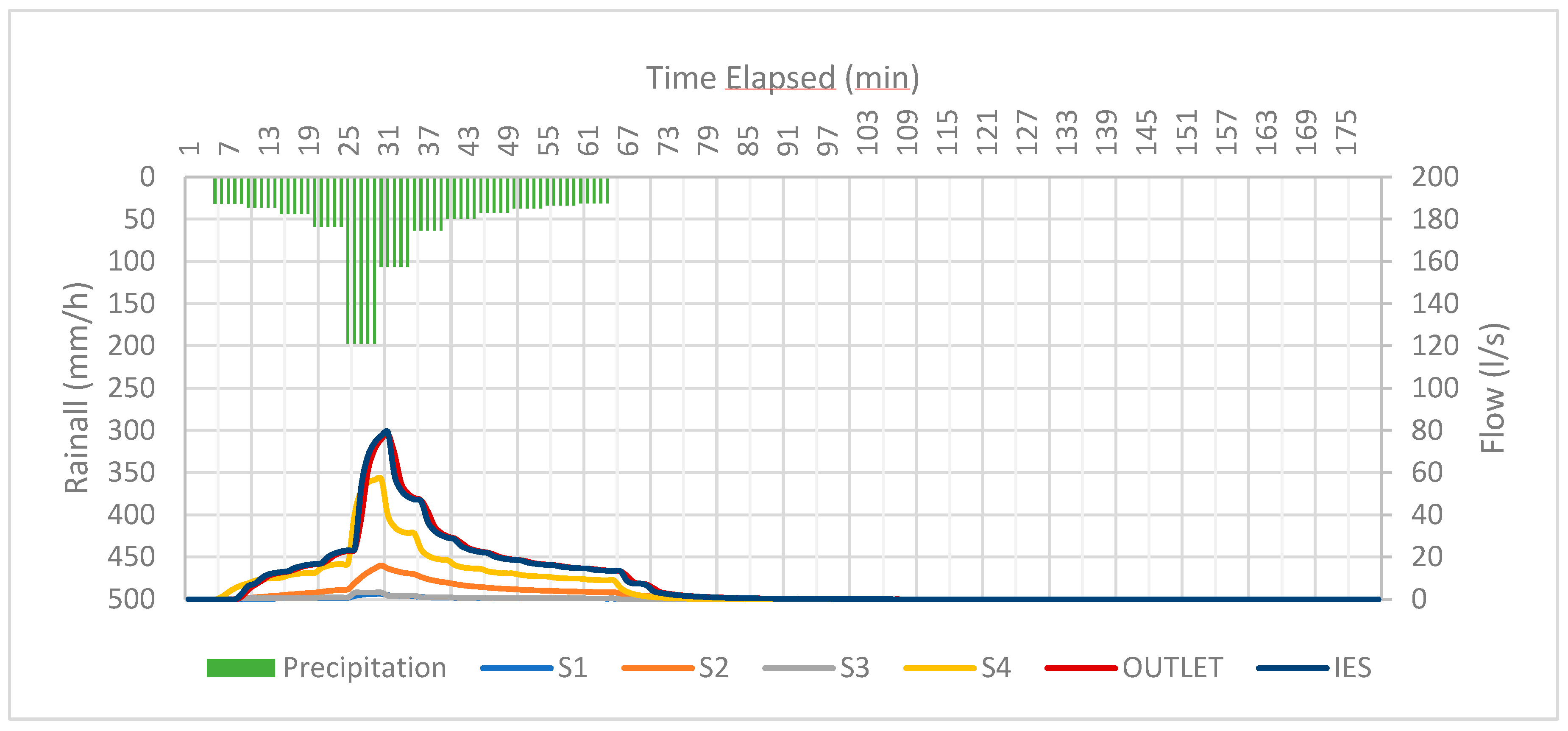1. Introduction
The traditional approach of stormwater management to collecting, conveying, and discharging runoff is becoming impractical in the current growing urbanization scenario and altered precipitation patterns, with high-intensity events being observed more frequently. The contaminants present on runoff after washing off surfaces are an important cause of river and stream pollution. To avoid saturation of the urban drainage system and improve water quality, current strategies for stormwater management act on water management in its source and encouraging systems that also function on water treatment. These systems are often referred to as SuDs (sustainable urban drainage systems), green infrastructures, BMPs (best management practices), LIDs (low impact developments). This approach is already mentioned in public policies on urban drainage and land use, especially by limiting the discharge and requiring detention or retention tanks [
1].
The application of these strategies for stormwater control may be difficult, especially in fully developed urban areas. Retrofitting of such areas is usually more expensive and may be limited to few urban spaces. One of the more feasible and effective interventions is the change of traditional road, pavement, and parking surfaces for permeable ones.
However, these alterations are limited by the need to find a trade-off between good infiltration performance and sufficient strength to traffic loads. That is the reason for which this solution is often applied only to roads with low traffic loads.
An alternative is to limit the adaptations to road gutters that are less stressed by dynamic loads. The use of an infiltration-exfiltration system as street gutters, consisting of a porous concrete surface with a gravel base, may achieve several goals. First, stormwater runoff to be discharged into the sewer network is reduced. Second, peaks of stormwater flow into the sewer network are reduced, due to the temporary storage inside the porous layers of the part of stormwater runoff that cannot be infiltrated. Third, the porous surface acts as a filter, promoting load removal from runoff. Previous research analyzed the IES performance on runoff peak flow and volume reduction [
2] and on load removal [
3].
2. Material and Methods
2.1. Experimental Area
An IES road gutter was installed in the headquarters of the Brazilian Portland Cement Association (ABCP) located in São Paulo, Brazil. The system has 49 cm width and 1880 cm length and a cross-section consisting of a 10 cm surface of pervious concrete and 20 cm of gravel over a natural soil subbase, without geotextile and is connected to an inlet PVC pipe (
Figure 1).
The IES was placed on the entrance road and received stormwater of 1626 square meters contribution area on half of the entrance road and two parking lots with hexagonal concrete blocks surface and two grass garden areas according
Table 1 and
Figure 2.
The pervious concrete was placed over the gravel layer and compacted using a manual compaction hammer due to space restriction. It is important to notice that compaction can alter pervious concrete characteristics [
4].
2.2. Pervious Concrete Characteristics
The pervious concrete surface consists of a mix design containing a cement type CP V Ari (high initial resistance), aggregates, and admixture. Specimens mold on laboratory were tested for compressive strength on a cylindric specimen (ABNT NBR 5739), flexural strength on a prismatic specimen, and diametral compressive strength. Samples extracted from the finished area were tested for water absorption, void content, and density.
2.3. Infiltration Rate
Permeability tests were held on the finish area using a falling head permeameter with a 30 cm diameter and a water head test level between 10 and 15 mm, according to ABNT NBR 16,416. Details of the permeability test method can be found in [
5]. The first test (2 October 2019) was held after a rainfall event carried particle load from the garden area towards the IES, visually clogging the system. Before the second measure (17 October 2019), the IES was cleaned by regular sweeping, and before the third test, (23 October 2019) with pressure water.
2.4. Rainfall-Runoff Modelling
The stormwater management model (SWMM) was used to simulate the rainfall-runoff transformation considering the previous scenario, before the IES installation, and after. The simulation used typical urban area subcatchments parameters. For the concrete block pavement area, a 0.01 Manning Number was used. For both garden areas, the Horton infiltration model with a minimum infiltration rate of 0.5 mm/h was used. The depression storage was adopted as 0.05 mm for both pervious and impervious areas. For the IES simulation, the LID build-in function of SWMM was used considering a seepage rate of 0.3 mm/h, coherent with the low permeability soil typical of that area, and a drain placed on the lower part of the storage layer (gravel layer). For the simulations, Chicago-storm hyetograph obtained with the IDF (Intensity-Duration-Frequency) equation from IAG-USP was used [
6]. With the rainfall-runoff simulations the outlet and subcatchments hydrograph were obtained for the pre and post retrofit scenario and the IES performance data.
3. Results
Results obtained for the pervious concrete characteristics, infiltration rate test on the IES surface, and the rainfall-runoff modeling results.
3.1. Pervious Concrete Characteristics
Laboratory samples molded with the proposed mix design presented the results gathered in
Table 2,
Table 3 and
Table 4.
Table 5 shows the results for water absorption, void content, and density from the samples extracted from the finished experimental area.
3.2. Infiltration Rate
The infiltration rate results are gathered in
Table 6. The infiltration rate obtained on 2 October 2019 preceded from a rainfall event that clogged the IES surface with soil particles load, however, the obtained rate is still enough to allow water infiltration. Before the second test (17 October 2019), the IES was cleaned by regular sweeping, presenting an increase in infiltration rate. The IES was then cleaned with pressure water achieving an infiltration rate of 17,786 mm/h.
3.3. Rainfall-Runoff Modelling
The rainfall-runoff simulation allowed to obtain the runoff peak flow, total runoff volume, and the hydrograph from the outlet, IES and subcatchments for the pre and post-retrofit scenarios (
Table 7,
Table 8 and
Table 9,
Figure 3 and
Figure 4).
4. Discussion
An infiltration-exfiltration system with 18.8 m length and 0.49 m width was built to receive rainfall from a 1617 m2 contribution area. The IES is on a pervious concrete layer (10 cm) and gravel layer (20 cm) and is connected to the drainage system through a 10 cm diameter PVC pipe. The pervious concrete layer presented a 20.8 MPa compressive strength, 2.43 MPa (average) flexural strength, and 2.32 MPa diametral compressive strength for 28 days age and laboratory molded specimens. Samples extracted presented 14.3% of void content. The IES infiltration rate was measured after a rainfall event, presenting a 2174 mm/h. After cleaning with pressure water, the infiltration rate raised to 17,786 mm/h. Rainfall-runoff simulation for the proposed IED did not register peak flow and volume reduction comparing pre and post-retrofit.
5. Conclusions
The current urbanization scenario demands a shift in stormwater management, favoring on-source solutions and encouraging reuse, infiltration, and temporary storage. These solutions are often referred to as SuDs (Sustainable Urban Drainage Systems) and provide runoff peak flow and volume attenuation while delivering amenities and biodiversity opportunities. However, it may be difficult to apply these systems in a fully urbanized environment requiring solutions that may be applied in a public space. The infiltration-exfiltration system placed in road gutters functions by reducing runoff peak flow and volume, avoiding ponding on gutters, and reducing drainage inlet maintenance. Previous research confirmed the performance of such systems.
An IES was built in the ABCP headquarters, in Brazil. The surface layer presented a high infiltration rate that allows stormwater infiltration. The pervious concrete characteristics were coherent with the low traffic vehicular use. The rainfall-runoff simulation did not show a reduction in peak flow and volume as expected. Considering the results, to improve IES performance on runoff peak flow and volume reduction, a deeper depth on the gravel layers and a flow restriction on the outlet tube would be necessary to facilitate storage. To facilitate infiltration, the outlet pipe could be placed in an offset position from the gravel layer and the system could also be combined with soakaways. The experimental area is going to be monitored to obtain data to calibrate and validate the rainfall-runoff model and to obtain load particle removal efficiency.
Author Contributions
C.O. conceived, designed, and follow up the experiments, M.M. contributed with the rainfall-runoff modelling and wrote the paper, G.B. analyzed the data. All authors have read and agreed to the published version of the manuscript.
Acknowledgments
The authors appreciate the contribution of RE9 Soluções Ecológicas and Polimix on funding the full-scale test and the ABCP on providing the space.
Conflicts of Interest
The authors declare no conflict of interest.
Abbreviations
The following abbreviations are used in this manuscript:
| ABCP | Brazilian Portland Cement Association |
| IDF | Intensity-Duration-Frequency |
| IES | infiltration-exfiltrarion system |
References
- Marchioni, M.L.; Becciu, G. Permeable Pavement Used on Sustainable Drainage Systems (SUDs): A Synthetic Review of Recent Literature; WIT Press Urban Water II: Southampton, UK, 2014; p. 12. [Google Scholar]
- Marchioni, M.; Becciu, G. Infiltration-exfiltration system for stormwater runoff volume and peak attenuation. Int. J. Saf. Secur. Eng. Southampton, United Kingdom 2018, 8, 473–483. [Google Scholar] [CrossRef]
- Teng, Z.; Sansalone, J. In situ partial exfiltration of rainfall runoff. II: Particle separation. J. Environ. Eng. 2004, 130, 1008–1020. [Google Scholar] [CrossRef]
- Brugin, M.; Marchioni, M.; Becciu, G.; Giustozzi, F.; Toraldo, E.; Andrés-Valeri, V.C. Clogging potential evaluation of porous mixture surfaces used in permeable pavement systems. Eur. J. Environ. Civ. Eng. 2020, 24, 620–630. [Google Scholar] [CrossRef]
- Marchioni, M.; Becciu, G.; Silva, C. Critical Analysis of the Brazilian National Standard for Concrete Permeable Pavement. WIT Trans. Ecol. Environ. 2015, 192, 443–453. [Google Scholar]
- Júnior, F.M.; Magni, N.L.G. Equações de chuvas intensas do Estado de São Paulo; Governo do Estado de São Paulo-Secretaria de Recursos Hídricos, Saneamento E Obras-Departamento de Águas E Energia Elétrica-Centro Tecnológico de Hidráulica E Recursos Hídricos: São Paulo, Brazil, 1999. [Google Scholar]
| Publisher’s Note: MDPI stays neutral with regard to jurisdictional claims in published maps and institutional affiliations. |
© 2019 by the authors. Licensee MDPI, Basel, Switzerland. This article is an open access article distributed under the terms and conditions of the Creative Commons Attribution (CC BY) license (https://creativecommons.org/licenses/by/4.0/).









